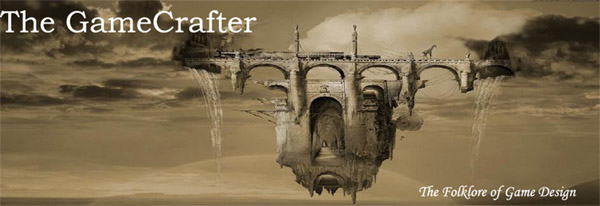Those who do not learn from History are doomed to repeat it.
Today’s “Gaming” has deeper roots that most individuals realize. To deny those roots and underlying cultural and psychological factors is to akin to painting a life-like painting with two colors. Astonishingly enough, that is exactly what most game designs and products have attempted to accomplish in recent memory.
The origins of “Gaming” are well documented and well ignored. The origins date back to ancient times of Kings and Pharos, princes and generals who used miniature representations of armies and leaders to better understand impending battles. This pastime was educational, very expensive and only in the hands of the elite of society.
In more modern times, this pastime, termed “Wargaming” was a hobby in
The big breakthrough however was in 1972 when a very small company in
At the same time unique things were happening in other mediums, such as books, comics, and movies: An explosion of Fantasy authors and books, the rise of the Marvel universe in comic-books, and the release of the science fiction movies Star Trek and Star Wars. All of these fed the imaginations of gamers and launched millions of hours of interactive story-telling around such rules sets as Traveler, Gammaworld, Dungeons and Dragons, Champions, the Auruin Grimoire, Chivalry and Sorcery and Empire of the Petal Throne to name just a few. Supplements came from companies like the Judges Guild, and TSR that started us down a path of “Canned Adventures” that we find heavily influencing game design and the games produced today.
This new form of expression slightly predated the evolution of technology into household forms such as the home computer. The introduction of affordable technology accelerated the interest of this expression by adding yet another discipline into the mix, that of art.
In the 1980s several dominant forms of this expression began to take shape, interrelate, interconnect and expand. There existed the tabletop miniature market, the role playing market, the boxed game market, the play-by-mail market and finally with the addition of technology, with the added artistic expression, the computer game market that crossed all of these aforementioned low technology markets.
The roleplaying market expanded with an emphasis upon storytelling and evolution of game-worlds, plotlines and characters framed by elaborate rule sets designed to simulate heroic archetypes. The original introduction of Dungeons and Dragons spawned hundreds of rules sets, thousands of published works, the vast majority of which did not survive the marketing strength of the main competitors. It is of note that the survivors of this time period did not necessarily have better rules or products, but better marketing machines. A lesson still not learned by most technology companies today.
The miniature market expanded with the focus of fantasy and science fiction elements and expansion of rules sets to simulate such imaginary battles.
The Play-by-mail market, born in 1975 and thrived until the late 1990’s, was a combination form of entertainment that allowed multiple players to compete/play with and against one another using turn based systems encapsulating all of the low tech markets of role-playing, military simulation and adding political and economic simulations as well.
The boxed set market was still led by the Avalon Hill Game company in the 1980’s slowly began to dwindle in the pure military simulation sense. Later in the 1990’s picked up again by primarily German companies and designs using more abstract and innovative game mechanics to become a popular method of entertainment today.
Technologic Innovation:
We know well the impact of technology on our day-to-day lives, and at no time in our history has an event so changed world society in such a way. For our purposes we need to look at several factors of technology and how it has modified entertainment and to a lesser degree, the impact this has on the lives of those who engage actively or passively in technologic entertainment.
From low technology origins, the computer game market exploded in the 1980’s and over the last 25 years has become a very popular and lucrative form of entertainment. Initially computer games were limited in scope and power to engage the player in manual dexterity and coordination simulations. As power of the computers expanded, so did the complexity and artwork of these products. The operative word being product. Initially we had point of sale computer game products designed primarily for a single person to engage a computer in some form of simulation or story. New products enticed players with better graphics or artwork designed to appeal at the point of purchase and by and large the game play aspects were secondary considerations. In fact, under this business model, the only way to survive was to create a steady stream of products that eclipsed previous products, which historically have been at the point of purchase. In other words, the key innovations have revolved around the realistic expression of artwork and eye candy to entice a consumer to purchase a new product.
Technology has also played a key role in other forms of literature and art. Stage and theatre have been eclipsed with technological breakthroughs that have given us new forms of expression namely television, and film. Advances in artwork, special effects, computer aided graphics and simulation have given birth to forms of expression never before possible in our history.
Which brings us to the current day.
What we see today is the macro trend of the slow convergence of literary forms into a single technologic powered form of entertainment that can be both passive and active in nature. Today few computer games are created that does not support some sort of multi-player option and interactive cable-TV is being developed and released to target markets.
The form of gaming that has been termed “On-Line gaming”, provides a very unique opportunity to cross many fields of entertainment. The most current term used to describe this genre is Massive Multiplayer Online Role Playing Game or MMORPG. Like the computer game market did to the low tech gaming markets, this form of entertainment has the unrealized potential to cut across many existing game genres and other non-technologic entertainment fields.
I touched on many things here.. and will elaborate further shortly.
.
.





No comments:
Post a Comment